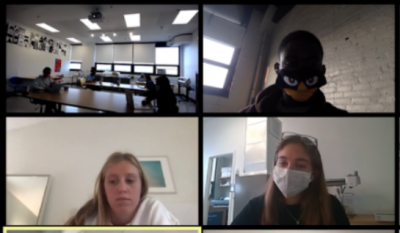The Learn from Anywhere hybrid model has changed the makeup of a typical Boston University classroom. Some professors who previously had a full lecture hall now find themselves teaching to a room of 20, with the rest of the class on a computer screen. For others, everything is online.

Dana Janbek, a master lecturer in the College of Communication, said about a third of her class is attending in person this semester, compared to nearly full attendance before the pandemic.
This shift to smaller in-person classes combined with an online equivalent has created some difficulties for instructors as well as students, Janbek said.
“It’s also challenging to manage both your online students, your in-person students and your students who are going to watch the lecture later on,” Janbek said. “And obviously, you’re only seeing students with their masks on and it’s not easy to gauge their reaction and their comprehension of course content because you’re only seeing their eyes.”
As professors struggle to manage an audience across formats, some students who are taking classes entirely on Zoom have trouble hearing those who are physically in the classroom. Ariane Vigna, a junior in COM and the College of Arts and Sciences, said being a student is particularly difficult at this time.
“It gets really annoying when it’s hybrid,” Vigna said, “because then I can’t really hear the professor well, I can’t see them well, sometimes I don’t see my classmates.”
Despite these issues with Zoom, Vigna said she takes classes remotely instead of in person when she can. If professors can’t freely choose their preferred method of teaching, Vigna said she would rather stay home.
“We don’t really know what professors would want,” Vigna said. “I don’t want to put them in danger, or have them feel uncomfortable and worry for their health or their family’s health.”
CAS junior Marla Olmstead said her in-class experience was “awkward” because she was one of two people attending.
“It’s just a weird experience with the masks and everything and there’s barely anyone there,” Olmstead said. “I almost get more out of it being away from the classroom.”
While some students find the in-person environment jolting, others prefer it to Zoom.
Sarah Schwartz, a freshman in CAS, said she tries to go to class in person as often as possible.
“I feel more productive when I’m in class because there’s less distraction,” Schwartz said, “as opposed to being in my room.”
On the other hand, Schwartz said her roommate finds that as the semester gets busier, the option to attend class remotely on any given day provides welcome flexibility.
“My roommate prefers not to go because she has so many things going on that things overlap,” Schwartz said. “She just prefers to do everything from one spot.”
Paula Austin, an assistant professor of African American Studies, wrote in an email that the added technological challenge is not the only factor that contributes to this semester being more difficult.
“What has come through this experience for me is that it hasn’t been exclusively the tech that has made this difficult but the (extra) emotional and cognitive work that it takes to conduct class,” Austin wrote. “It is made even tougher by the public health crisis context AND the national political and social contexts – anti-Black police violence, racial uprisings, and the election.”
Janbek said she has seen how Zoom can provide a means for students to participate and connect with one another.
“The chat function is allowing for a community to be formed in ways that is different than in person,” Janbek said. “It’s much easier and faster for students to share their answers to questions that faculty raise. So I think Zoom, in some ways, is building a community that’s different than in-person classes.”













